Contemporary Health Issues Report: Lung Foundation Australia Analysis
VerifiedAdded on 2020/10/23
|12
|3395
|388
Report
AI Summary
This report provides an in-depth analysis of contemporary health issues, specifically focusing on the Lung Foundation Australia (LFA). It begins with an introduction to health issues globally and then delves into the background and values of LFA, highlighting its role as a charity dedicated to supporting individuals with lung diseases. The report identifies chronic respiratory diseases as a significant health problem affecting the elderly population, detailing the causes, such as tobacco use, pollution, and genetic factors. It also outlines the LFA's values of courage, respect, collaboration, and compassion. The report then clearly states the aims and objectives of health policies and the advocacy efforts of the LFA, with a focus on both primary and secondary/tertiary prevention strategies. The report recommends actions for government authorities to take, including policy development, early detection programs, and promoting awareness. Finally, the report emphasizes the importance of early diagnosis, treatment, and health promotion activities to improve the quality of life for those affected by lung diseases.
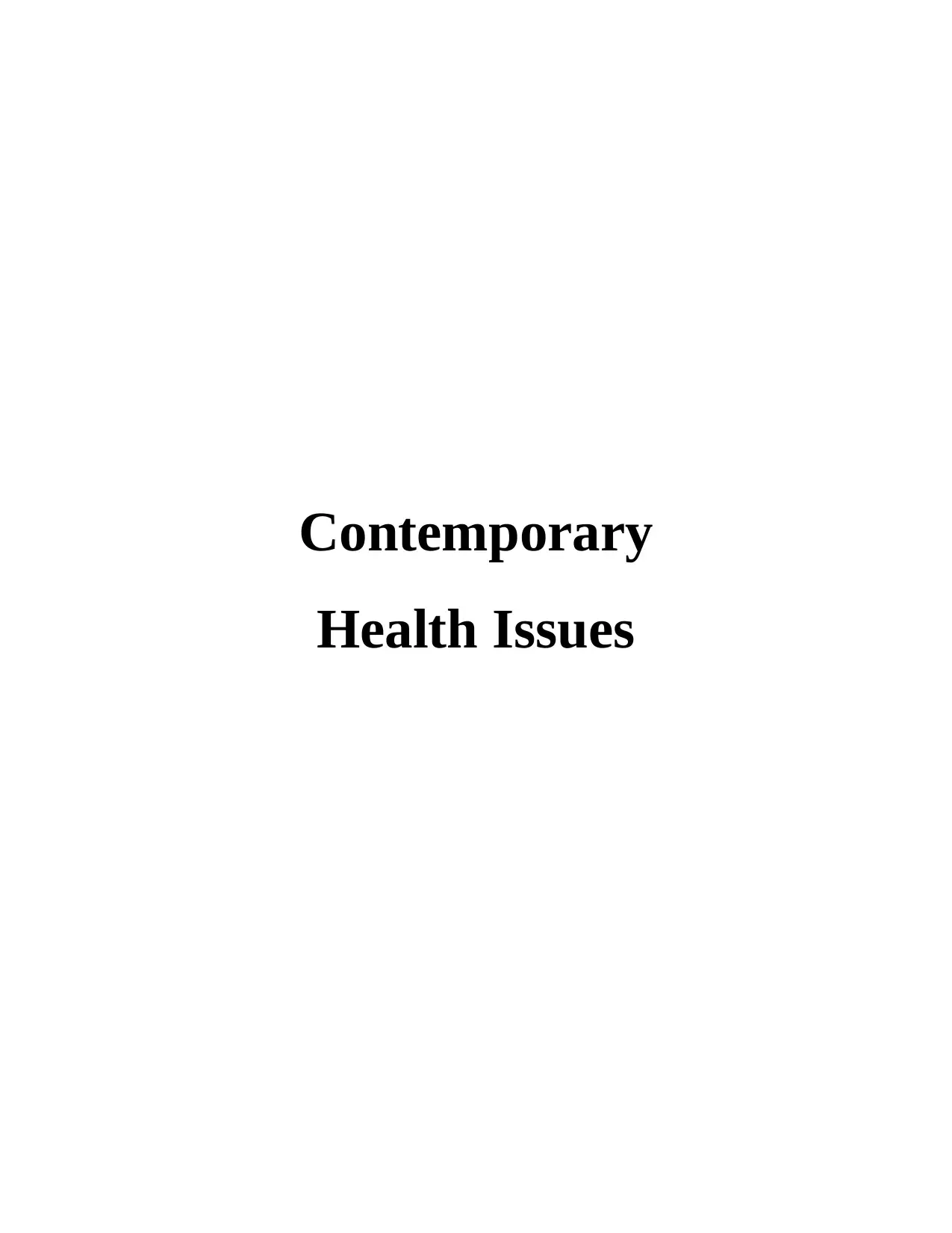
Contemporary
Health Issues
Health Issues
Paraphrase This Document
Need a fresh take? Get an instant paraphrase of this document with our AI Paraphraser
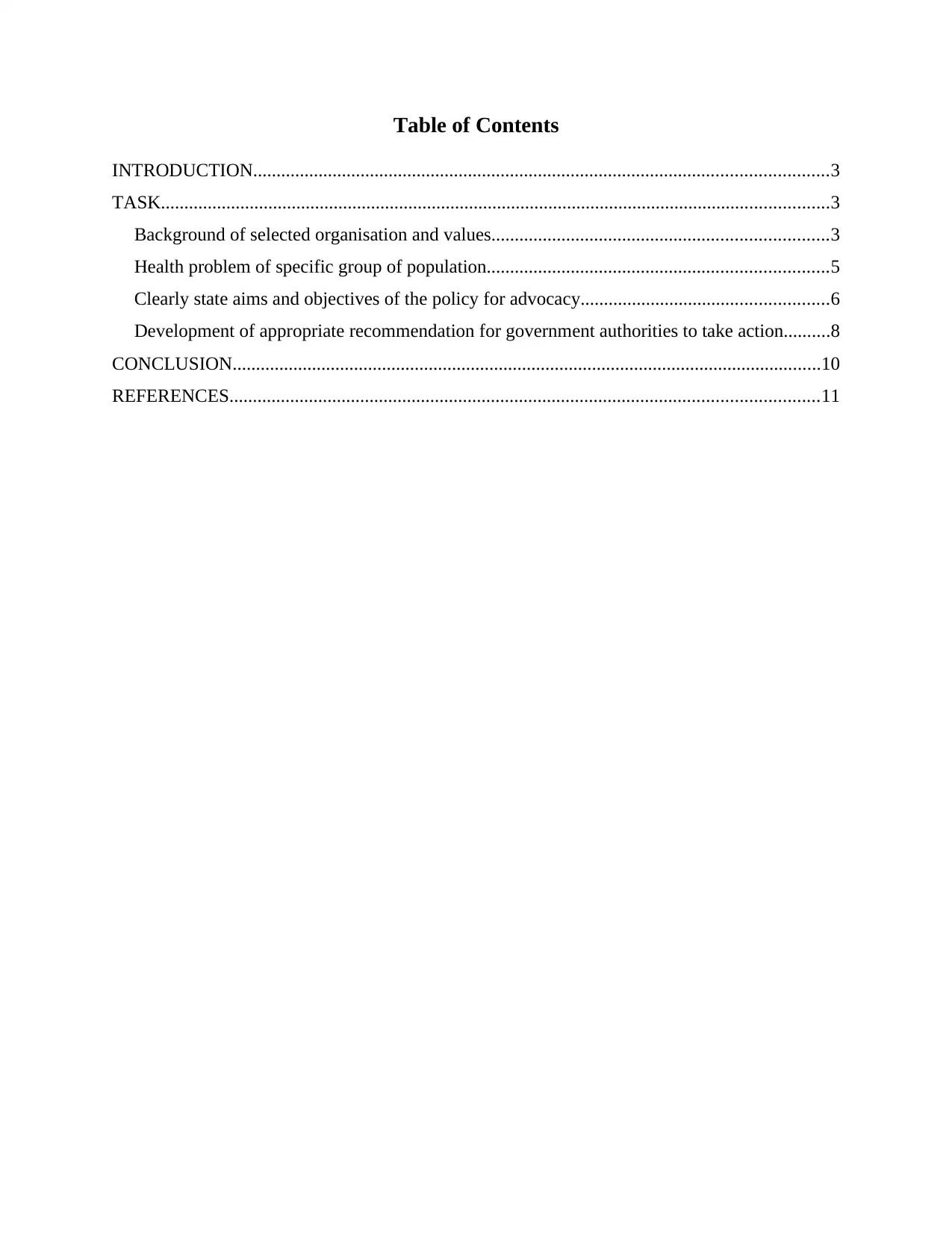
Table of Contents
INTRODUCTION...........................................................................................................................3
TASK...............................................................................................................................................3
Background of selected organisation and values........................................................................3
Health problem of specific group of population.........................................................................5
Clearly state aims and objectives of the policy for advocacy.....................................................6
Development of appropriate recommendation for government authorities to take action..........8
CONCLUSION..............................................................................................................................10
REFERENCES..............................................................................................................................11
INTRODUCTION...........................................................................................................................3
TASK...............................................................................................................................................3
Background of selected organisation and values........................................................................3
Health problem of specific group of population.........................................................................5
Clearly state aims and objectives of the policy for advocacy.....................................................6
Development of appropriate recommendation for government authorities to take action..........8
CONCLUSION..............................................................................................................................10
REFERENCES..............................................................................................................................11
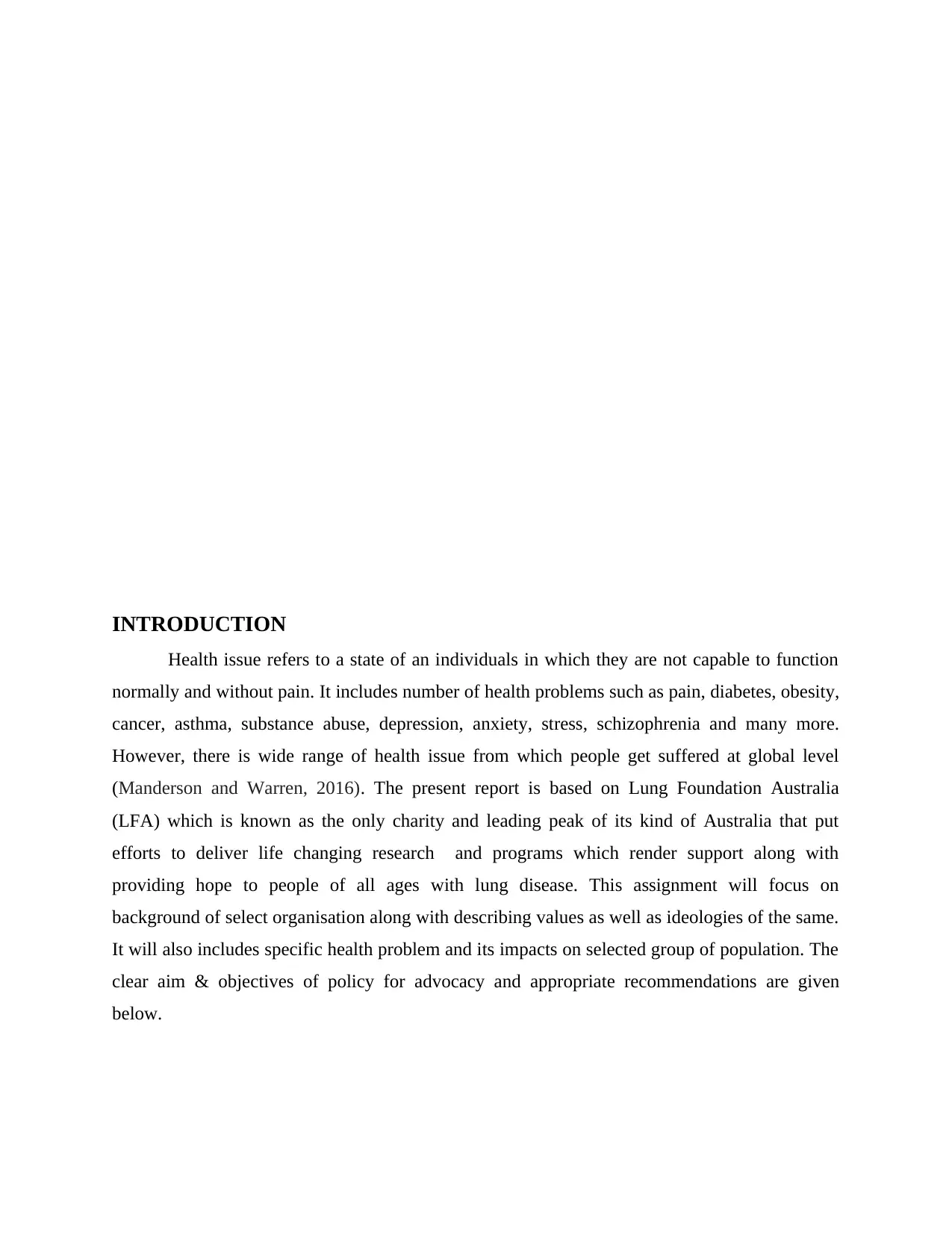
INTRODUCTION
Health issue refers to a state of an individuals in which they are not capable to function
normally and without pain. It includes number of health problems such as pain, diabetes, obesity,
cancer, asthma, substance abuse, depression, anxiety, stress, schizophrenia and many more.
However, there is wide range of health issue from which people get suffered at global level
(Manderson and Warren, 2016). The present report is based on Lung Foundation Australia
(LFA) which is known as the only charity and leading peak of its kind of Australia that put
efforts to deliver life changing research and programs which render support along with
providing hope to people of all ages with lung disease. This assignment will focus on
background of select organisation along with describing values as well as ideologies of the same.
It will also includes specific health problem and its impacts on selected group of population. The
clear aim & objectives of policy for advocacy and appropriate recommendations are given
below.
Health issue refers to a state of an individuals in which they are not capable to function
normally and without pain. It includes number of health problems such as pain, diabetes, obesity,
cancer, asthma, substance abuse, depression, anxiety, stress, schizophrenia and many more.
However, there is wide range of health issue from which people get suffered at global level
(Manderson and Warren, 2016). The present report is based on Lung Foundation Australia
(LFA) which is known as the only charity and leading peak of its kind of Australia that put
efforts to deliver life changing research and programs which render support along with
providing hope to people of all ages with lung disease. This assignment will focus on
background of select organisation along with describing values as well as ideologies of the same.
It will also includes specific health problem and its impacts on selected group of population. The
clear aim & objectives of policy for advocacy and appropriate recommendations are given
below.
⊘ This is a preview!⊘
Do you want full access?
Subscribe today to unlock all pages.

Trusted by 1+ million students worldwide
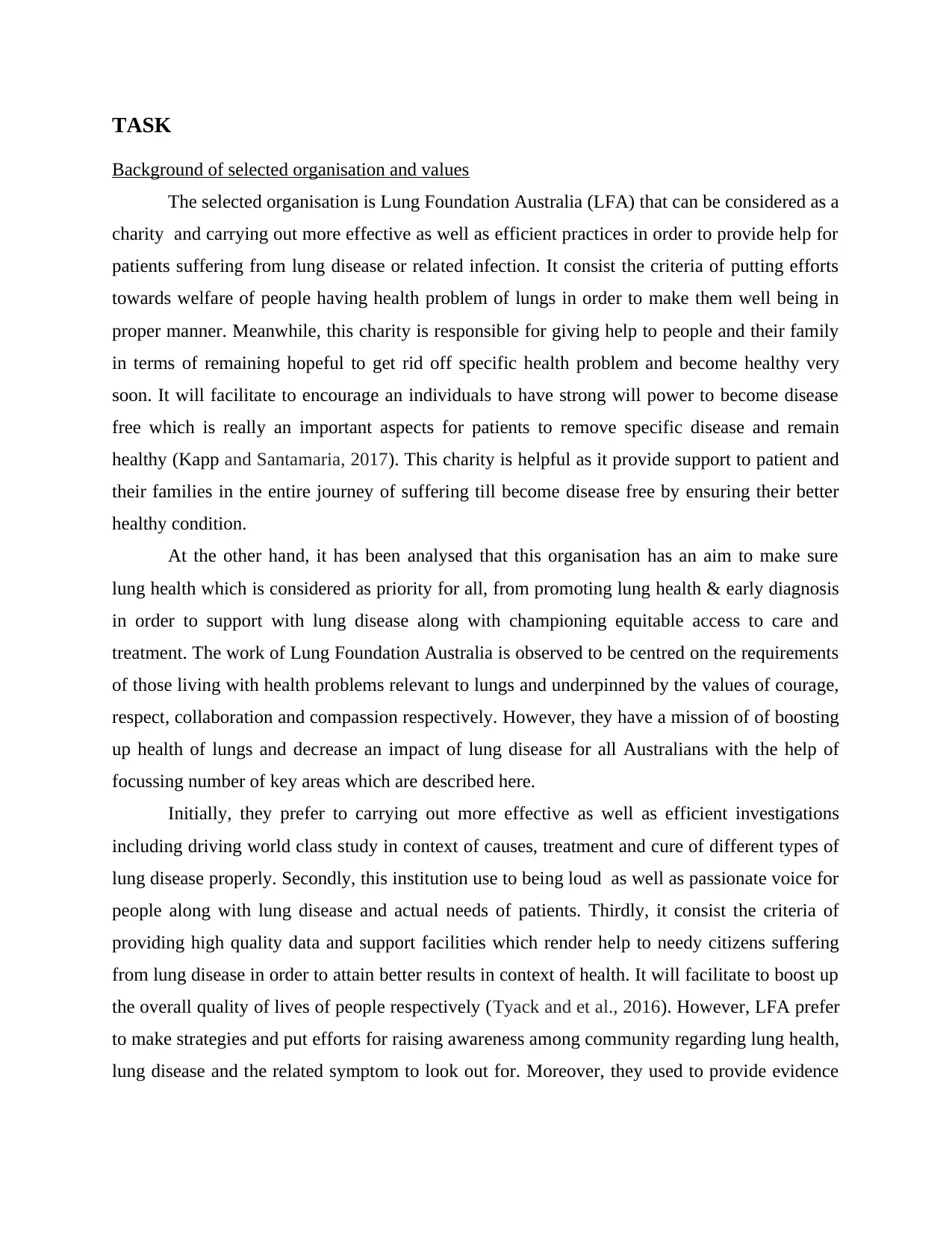
TASK
Background of selected organisation and values
The selected organisation is Lung Foundation Australia (LFA) that can be considered as a
charity and carrying out more effective as well as efficient practices in order to provide help for
patients suffering from lung disease or related infection. It consist the criteria of putting efforts
towards welfare of people having health problem of lungs in order to make them well being in
proper manner. Meanwhile, this charity is responsible for giving help to people and their family
in terms of remaining hopeful to get rid off specific health problem and become healthy very
soon. It will facilitate to encourage an individuals to have strong will power to become disease
free which is really an important aspects for patients to remove specific disease and remain
healthy (Kapp and Santamaria, 2017). This charity is helpful as it provide support to patient and
their families in the entire journey of suffering till become disease free by ensuring their better
healthy condition.
At the other hand, it has been analysed that this organisation has an aim to make sure
lung health which is considered as priority for all, from promoting lung health & early diagnosis
in order to support with lung disease along with championing equitable access to care and
treatment. The work of Lung Foundation Australia is observed to be centred on the requirements
of those living with health problems relevant to lungs and underpinned by the values of courage,
respect, collaboration and compassion respectively. However, they have a mission of of boosting
up health of lungs and decrease an impact of lung disease for all Australians with the help of
focussing number of key areas which are described here.
Initially, they prefer to carrying out more effective as well as efficient investigations
including driving world class study in context of causes, treatment and cure of different types of
lung disease properly. Secondly, this institution use to being loud as well as passionate voice for
people along with lung disease and actual needs of patients. Thirdly, it consist the criteria of
providing high quality data and support facilities which render help to needy citizens suffering
from lung disease in order to attain better results in context of health. It will facilitate to boost up
the overall quality of lives of people respectively (Tyack and et al., 2016). However, LFA prefer
to make strategies and put efforts for raising awareness among community regarding lung health,
lung disease and the related symptom to look out for. Moreover, they used to provide evidence
Background of selected organisation and values
The selected organisation is Lung Foundation Australia (LFA) that can be considered as a
charity and carrying out more effective as well as efficient practices in order to provide help for
patients suffering from lung disease or related infection. It consist the criteria of putting efforts
towards welfare of people having health problem of lungs in order to make them well being in
proper manner. Meanwhile, this charity is responsible for giving help to people and their family
in terms of remaining hopeful to get rid off specific health problem and become healthy very
soon. It will facilitate to encourage an individuals to have strong will power to become disease
free which is really an important aspects for patients to remove specific disease and remain
healthy (Kapp and Santamaria, 2017). This charity is helpful as it provide support to patient and
their families in the entire journey of suffering till become disease free by ensuring their better
healthy condition.
At the other hand, it has been analysed that this organisation has an aim to make sure
lung health which is considered as priority for all, from promoting lung health & early diagnosis
in order to support with lung disease along with championing equitable access to care and
treatment. The work of Lung Foundation Australia is observed to be centred on the requirements
of those living with health problems relevant to lungs and underpinned by the values of courage,
respect, collaboration and compassion respectively. However, they have a mission of of boosting
up health of lungs and decrease an impact of lung disease for all Australians with the help of
focussing number of key areas which are described here.
Initially, they prefer to carrying out more effective as well as efficient investigations
including driving world class study in context of causes, treatment and cure of different types of
lung disease properly. Secondly, this institution use to being loud as well as passionate voice for
people along with lung disease and actual needs of patients. Thirdly, it consist the criteria of
providing high quality data and support facilities which render help to needy citizens suffering
from lung disease in order to attain better results in context of health. It will facilitate to boost up
the overall quality of lives of people respectively (Tyack and et al., 2016). However, LFA prefer
to make strategies and put efforts for raising awareness among community regarding lung health,
lung disease and the related symptom to look out for. Moreover, they used to provide evidence
Paraphrase This Document
Need a fresh take? Get an instant paraphrase of this document with our AI Paraphraser

based training and programs in more effective as well as efficient manner in respect of
supporting health professionals in the delivery of best practices in context of clinical care.
Values of Lung Foundation Australia (LFA)
The physicians and other staff members are guided by appropriate values regarding
actions of leadership which is helpful to fulfil actual requirements of patients accurately.
However, it consist number of values such as integrity, excellence, teamwork & collaboration,
respect, compassion, innovation, stewardship, efficiency and diversity. In addition to this, the
another important value of Lung Foundation Australia is to maintain equality while providing
clinical services and medications for solving related disease of every citizens of the country.
They have policies like patient comes first and treat every person with respect & dignity.
Moreover, it consist to make staff members polite, friendly, helpful who can related with every
individual recognising their history, culture, relationships and actual needs to make the healthy
(Jowsey, 2016).
Ideologies of Lung Foundation Australia (LFA)
The ideologies can be described as belief systems around the allocation as well as use of
power in society. However, it consist the national care standards of care professionals in order to
make accurate decision making for providing effective medical services in an organisation for
their well being. In addition to this, it consist codes of conduct, standards for practices and codes
of ethics which is efficient to improve patient outcomes respectively.
Health problem of specific group of population
Chronic respiratory disease can be described as chronic health problems related to
airways and other parts of lungs in human body. It consist number of health issue in which some
of the re commonly observed in old age people such as asthma, chronic obstructive
pulmonary disease (COPD), occupational lung disease and pulmonary hypertension.
However, it had been analysed that individuals having their age between 65 to 74 years that are
considered to be at high risk of chronic respiratory diseases (Nguyen, Cumming and Hilmer,
2016). The target population for chronic respiratory disease is old age people because they are
generally observed to be suffering from such problems.
Causes of chronic respiratory disease in old age people
In addition to this, there are several causes of chronic respiratory disorders including
tobacco, pollution and exposure to fumes & gases. Initially, it has been analysed that tobacco
supporting health professionals in the delivery of best practices in context of clinical care.
Values of Lung Foundation Australia (LFA)
The physicians and other staff members are guided by appropriate values regarding
actions of leadership which is helpful to fulfil actual requirements of patients accurately.
However, it consist number of values such as integrity, excellence, teamwork & collaboration,
respect, compassion, innovation, stewardship, efficiency and diversity. In addition to this, the
another important value of Lung Foundation Australia is to maintain equality while providing
clinical services and medications for solving related disease of every citizens of the country.
They have policies like patient comes first and treat every person with respect & dignity.
Moreover, it consist to make staff members polite, friendly, helpful who can related with every
individual recognising their history, culture, relationships and actual needs to make the healthy
(Jowsey, 2016).
Ideologies of Lung Foundation Australia (LFA)
The ideologies can be described as belief systems around the allocation as well as use of
power in society. However, it consist the national care standards of care professionals in order to
make accurate decision making for providing effective medical services in an organisation for
their well being. In addition to this, it consist codes of conduct, standards for practices and codes
of ethics which is efficient to improve patient outcomes respectively.
Health problem of specific group of population
Chronic respiratory disease can be described as chronic health problems related to
airways and other parts of lungs in human body. It consist number of health issue in which some
of the re commonly observed in old age people such as asthma, chronic obstructive
pulmonary disease (COPD), occupational lung disease and pulmonary hypertension.
However, it had been analysed that individuals having their age between 65 to 74 years that are
considered to be at high risk of chronic respiratory diseases (Nguyen, Cumming and Hilmer,
2016). The target population for chronic respiratory disease is old age people because they are
generally observed to be suffering from such problems.
Causes of chronic respiratory disease in old age people
In addition to this, there are several causes of chronic respiratory disorders including
tobacco, pollution and exposure to fumes & gases. Initially, it has been analysed that tobacco
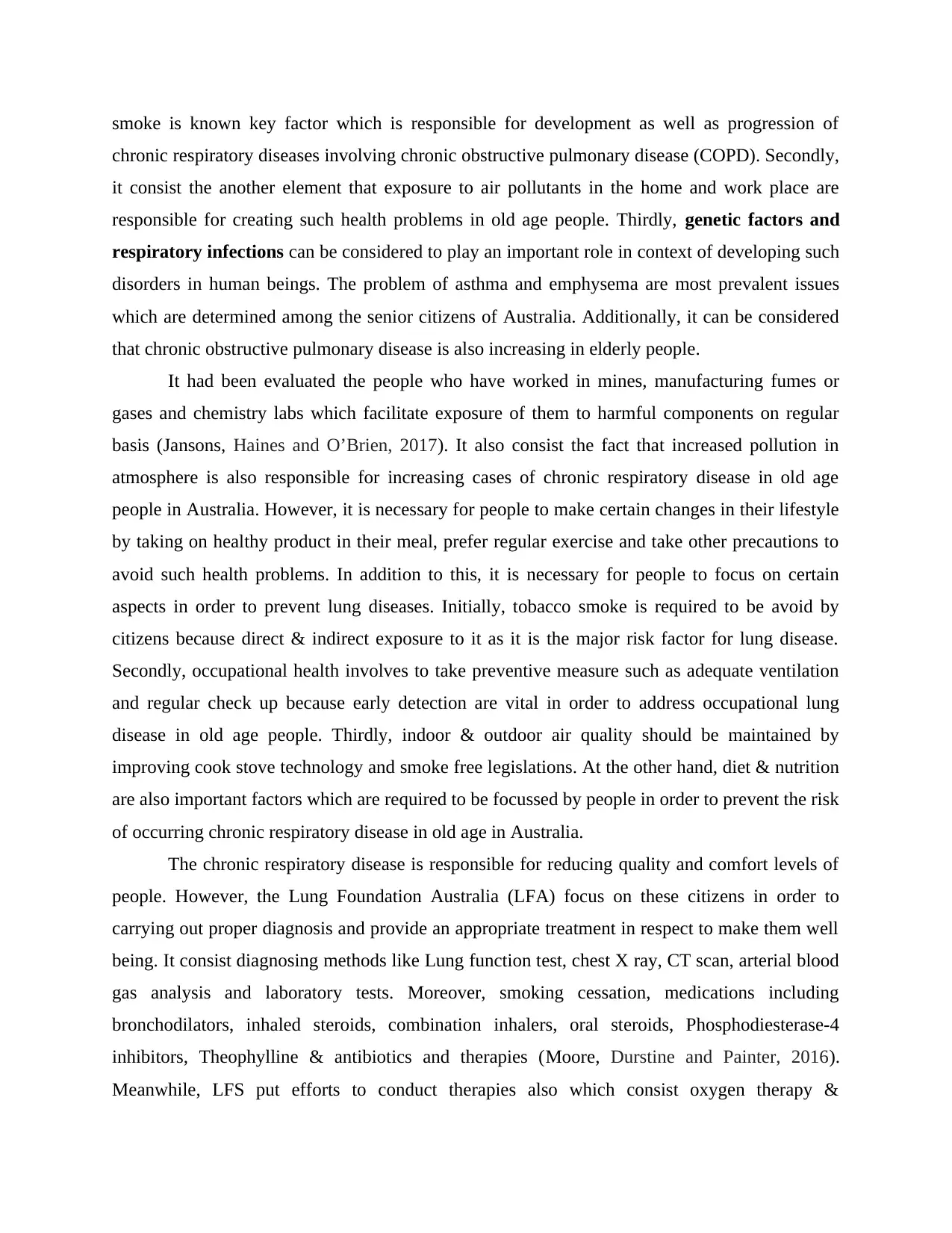
smoke is known key factor which is responsible for development as well as progression of
chronic respiratory diseases involving chronic obstructive pulmonary disease (COPD). Secondly,
it consist the another element that exposure to air pollutants in the home and work place are
responsible for creating such health problems in old age people. Thirdly, genetic factors and
respiratory infections can be considered to play an important role in context of developing such
disorders in human beings. The problem of asthma and emphysema are most prevalent issues
which are determined among the senior citizens of Australia. Additionally, it can be considered
that chronic obstructive pulmonary disease is also increasing in elderly people.
It had been evaluated the people who have worked in mines, manufacturing fumes or
gases and chemistry labs which facilitate exposure of them to harmful components on regular
basis (Jansons, Haines and O’Brien, 2017). It also consist the fact that increased pollution in
atmosphere is also responsible for increasing cases of chronic respiratory disease in old age
people in Australia. However, it is necessary for people to make certain changes in their lifestyle
by taking on healthy product in their meal, prefer regular exercise and take other precautions to
avoid such health problems. In addition to this, it is necessary for people to focus on certain
aspects in order to prevent lung diseases. Initially, tobacco smoke is required to be avoid by
citizens because direct & indirect exposure to it as it is the major risk factor for lung disease.
Secondly, occupational health involves to take preventive measure such as adequate ventilation
and regular check up because early detection are vital in order to address occupational lung
disease in old age people. Thirdly, indoor & outdoor air quality should be maintained by
improving cook stove technology and smoke free legislations. At the other hand, diet & nutrition
are also important factors which are required to be focussed by people in order to prevent the risk
of occurring chronic respiratory disease in old age in Australia.
The chronic respiratory disease is responsible for reducing quality and comfort levels of
people. However, the Lung Foundation Australia (LFA) focus on these citizens in order to
carrying out proper diagnosis and provide an appropriate treatment in respect to make them well
being. It consist diagnosing methods like Lung function test, chest X ray, CT scan, arterial blood
gas analysis and laboratory tests. Moreover, smoking cessation, medications including
bronchodilators, inhaled steroids, combination inhalers, oral steroids, Phosphodiesterase-4
inhibitors, Theophylline & antibiotics and therapies (Moore, Durstine and Painter, 2016).
Meanwhile, LFS put efforts to conduct therapies also which consist oxygen therapy &
chronic respiratory diseases involving chronic obstructive pulmonary disease (COPD). Secondly,
it consist the another element that exposure to air pollutants in the home and work place are
responsible for creating such health problems in old age people. Thirdly, genetic factors and
respiratory infections can be considered to play an important role in context of developing such
disorders in human beings. The problem of asthma and emphysema are most prevalent issues
which are determined among the senior citizens of Australia. Additionally, it can be considered
that chronic obstructive pulmonary disease is also increasing in elderly people.
It had been evaluated the people who have worked in mines, manufacturing fumes or
gases and chemistry labs which facilitate exposure of them to harmful components on regular
basis (Jansons, Haines and O’Brien, 2017). It also consist the fact that increased pollution in
atmosphere is also responsible for increasing cases of chronic respiratory disease in old age
people in Australia. However, it is necessary for people to make certain changes in their lifestyle
by taking on healthy product in their meal, prefer regular exercise and take other precautions to
avoid such health problems. In addition to this, it is necessary for people to focus on certain
aspects in order to prevent lung diseases. Initially, tobacco smoke is required to be avoid by
citizens because direct & indirect exposure to it as it is the major risk factor for lung disease.
Secondly, occupational health involves to take preventive measure such as adequate ventilation
and regular check up because early detection are vital in order to address occupational lung
disease in old age people. Thirdly, indoor & outdoor air quality should be maintained by
improving cook stove technology and smoke free legislations. At the other hand, diet & nutrition
are also important factors which are required to be focussed by people in order to prevent the risk
of occurring chronic respiratory disease in old age in Australia.
The chronic respiratory disease is responsible for reducing quality and comfort levels of
people. However, the Lung Foundation Australia (LFA) focus on these citizens in order to
carrying out proper diagnosis and provide an appropriate treatment in respect to make them well
being. It consist diagnosing methods like Lung function test, chest X ray, CT scan, arterial blood
gas analysis and laboratory tests. Moreover, smoking cessation, medications including
bronchodilators, inhaled steroids, combination inhalers, oral steroids, Phosphodiesterase-4
inhibitors, Theophylline & antibiotics and therapies (Moore, Durstine and Painter, 2016).
Meanwhile, LFS put efforts to conduct therapies also which consist oxygen therapy &
⊘ This is a preview!⊘
Do you want full access?
Subscribe today to unlock all pages.

Trusted by 1+ million students worldwide
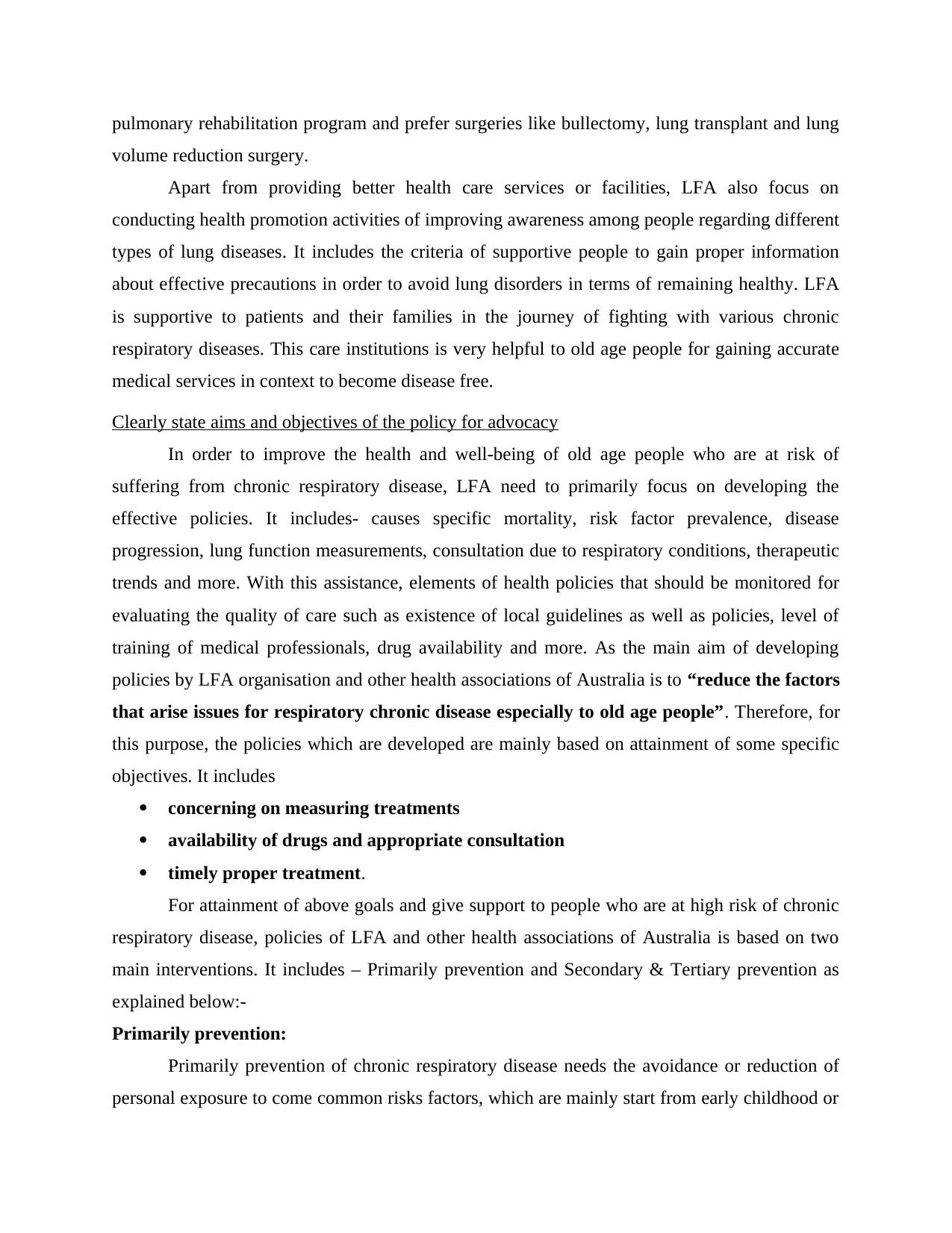
pulmonary rehabilitation program and prefer surgeries like bullectomy, lung transplant and lung
volume reduction surgery.
Apart from providing better health care services or facilities, LFA also focus on
conducting health promotion activities of improving awareness among people regarding different
types of lung diseases. It includes the criteria of supportive people to gain proper information
about effective precautions in order to avoid lung disorders in terms of remaining healthy. LFA
is supportive to patients and their families in the journey of fighting with various chronic
respiratory diseases. This care institutions is very helpful to old age people for gaining accurate
medical services in context to become disease free.
Clearly state aims and objectives of the policy for advocacy
In order to improve the health and well-being of old age people who are at risk of
suffering from chronic respiratory disease, LFA need to primarily focus on developing the
effective policies. It includes- causes specific mortality, risk factor prevalence, disease
progression, lung function measurements, consultation due to respiratory conditions, therapeutic
trends and more. With this assistance, elements of health policies that should be monitored for
evaluating the quality of care such as existence of local guidelines as well as policies, level of
training of medical professionals, drug availability and more. As the main aim of developing
policies by LFA organisation and other health associations of Australia is to “reduce the factors
that arise issues for respiratory chronic disease especially to old age people”. Therefore, for
this purpose, the policies which are developed are mainly based on attainment of some specific
objectives. It includes
concerning on measuring treatments
availability of drugs and appropriate consultation
timely proper treatment.
For attainment of above goals and give support to people who are at high risk of chronic
respiratory disease, policies of LFA and other health associations of Australia is based on two
main interventions. It includes – Primarily prevention and Secondary & Tertiary prevention as
explained below:-
Primarily prevention:
Primarily prevention of chronic respiratory disease needs the avoidance or reduction of
personal exposure to come common risks factors, which are mainly start from early childhood or
volume reduction surgery.
Apart from providing better health care services or facilities, LFA also focus on
conducting health promotion activities of improving awareness among people regarding different
types of lung diseases. It includes the criteria of supportive people to gain proper information
about effective precautions in order to avoid lung disorders in terms of remaining healthy. LFA
is supportive to patients and their families in the journey of fighting with various chronic
respiratory diseases. This care institutions is very helpful to old age people for gaining accurate
medical services in context to become disease free.
Clearly state aims and objectives of the policy for advocacy
In order to improve the health and well-being of old age people who are at risk of
suffering from chronic respiratory disease, LFA need to primarily focus on developing the
effective policies. It includes- causes specific mortality, risk factor prevalence, disease
progression, lung function measurements, consultation due to respiratory conditions, therapeutic
trends and more. With this assistance, elements of health policies that should be monitored for
evaluating the quality of care such as existence of local guidelines as well as policies, level of
training of medical professionals, drug availability and more. As the main aim of developing
policies by LFA organisation and other health associations of Australia is to “reduce the factors
that arise issues for respiratory chronic disease especially to old age people”. Therefore, for
this purpose, the policies which are developed are mainly based on attainment of some specific
objectives. It includes
concerning on measuring treatments
availability of drugs and appropriate consultation
timely proper treatment.
For attainment of above goals and give support to people who are at high risk of chronic
respiratory disease, policies of LFA and other health associations of Australia is based on two
main interventions. It includes – Primarily prevention and Secondary & Tertiary prevention as
explained below:-
Primarily prevention:
Primarily prevention of chronic respiratory disease needs the avoidance or reduction of
personal exposure to come common risks factors, which are mainly start from early childhood or
Paraphrase This Document
Need a fresh take? Get an instant paraphrase of this document with our AI Paraphraser
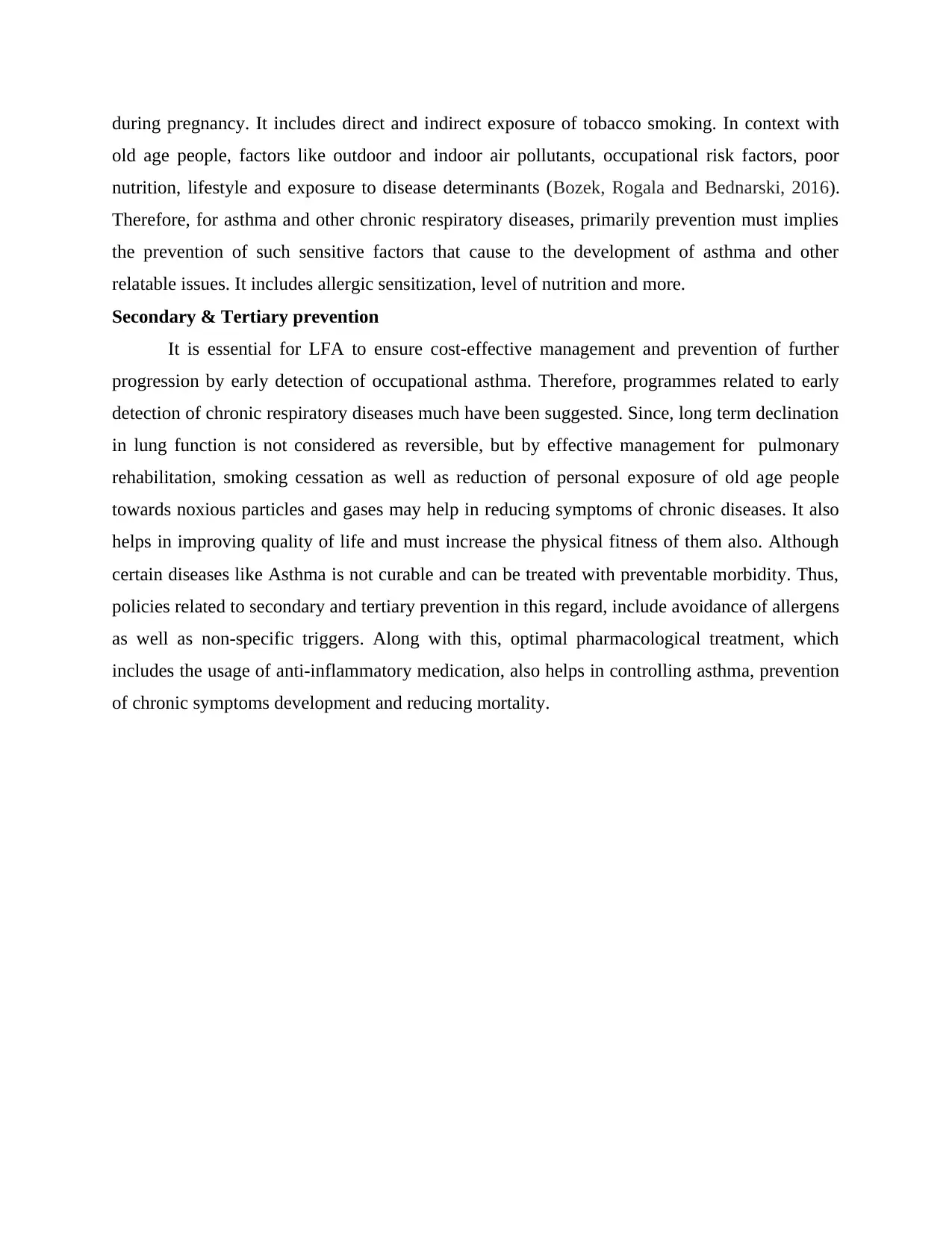
during pregnancy. It includes direct and indirect exposure of tobacco smoking. In context with
old age people, factors like outdoor and indoor air pollutants, occupational risk factors, poor
nutrition, lifestyle and exposure to disease determinants (Bozek, Rogala and Bednarski, 2016).
Therefore, for asthma and other chronic respiratory diseases, primarily prevention must implies
the prevention of such sensitive factors that cause to the development of asthma and other
relatable issues. It includes allergic sensitization, level of nutrition and more.
Secondary & Tertiary prevention
It is essential for LFA to ensure cost-effective management and prevention of further
progression by early detection of occupational asthma. Therefore, programmes related to early
detection of chronic respiratory diseases much have been suggested. Since, long term declination
in lung function is not considered as reversible, but by effective management for pulmonary
rehabilitation, smoking cessation as well as reduction of personal exposure of old age people
towards noxious particles and gases may help in reducing symptoms of chronic diseases. It also
helps in improving quality of life and must increase the physical fitness of them also. Although
certain diseases like Asthma is not curable and can be treated with preventable morbidity. Thus,
policies related to secondary and tertiary prevention in this regard, include avoidance of allergens
as well as non-specific triggers. Along with this, optimal pharmacological treatment, which
includes the usage of anti-inflammatory medication, also helps in controlling asthma, prevention
of chronic symptoms development and reducing mortality.
old age people, factors like outdoor and indoor air pollutants, occupational risk factors, poor
nutrition, lifestyle and exposure to disease determinants (Bozek, Rogala and Bednarski, 2016).
Therefore, for asthma and other chronic respiratory diseases, primarily prevention must implies
the prevention of such sensitive factors that cause to the development of asthma and other
relatable issues. It includes allergic sensitization, level of nutrition and more.
Secondary & Tertiary prevention
It is essential for LFA to ensure cost-effective management and prevention of further
progression by early detection of occupational asthma. Therefore, programmes related to early
detection of chronic respiratory diseases much have been suggested. Since, long term declination
in lung function is not considered as reversible, but by effective management for pulmonary
rehabilitation, smoking cessation as well as reduction of personal exposure of old age people
towards noxious particles and gases may help in reducing symptoms of chronic diseases. It also
helps in improving quality of life and must increase the physical fitness of them also. Although
certain diseases like Asthma is not curable and can be treated with preventable morbidity. Thus,
policies related to secondary and tertiary prevention in this regard, include avoidance of allergens
as well as non-specific triggers. Along with this, optimal pharmacological treatment, which
includes the usage of anti-inflammatory medication, also helps in controlling asthma, prevention
of chronic symptoms development and reducing mortality.
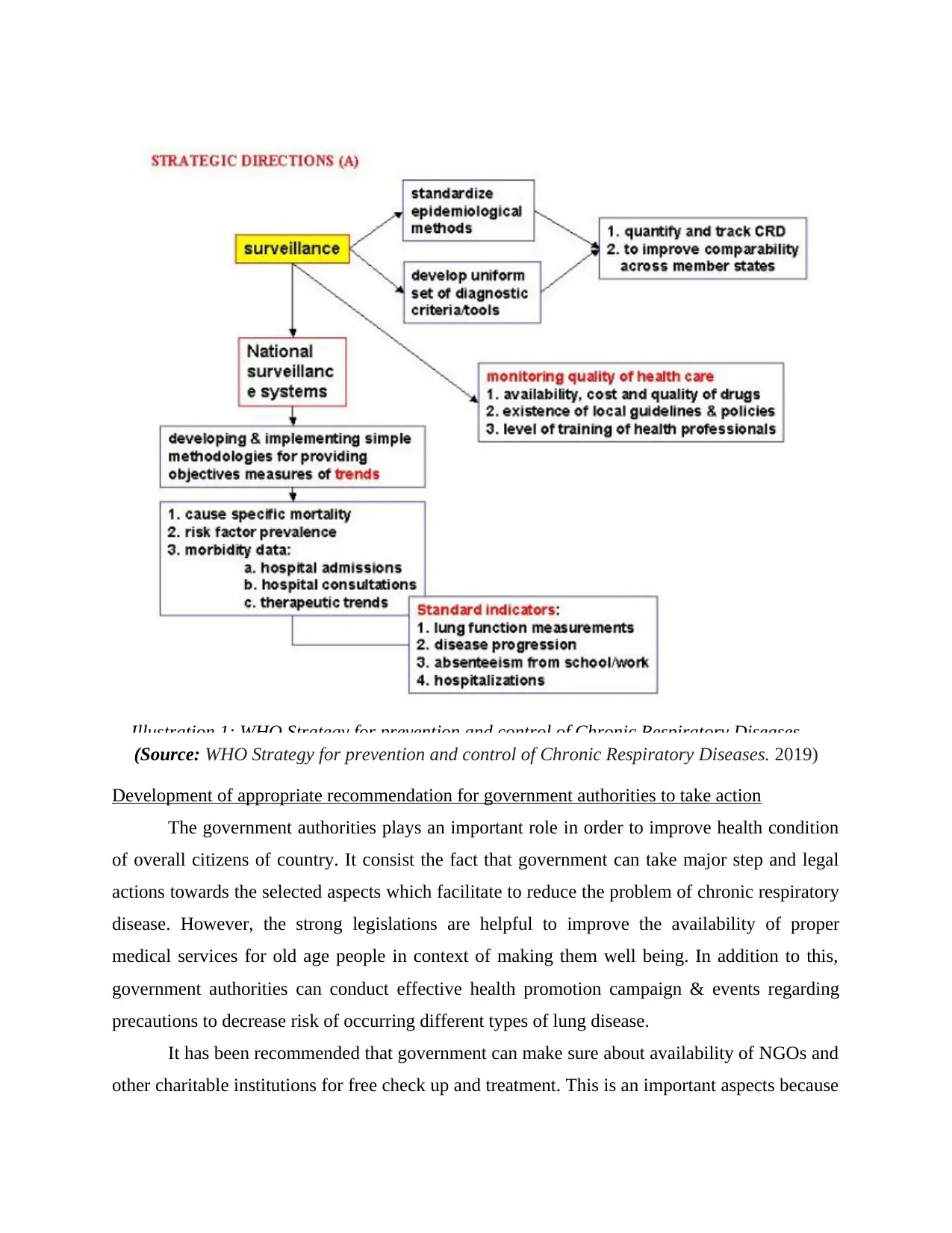
(Source: WHO Strategy for prevention and control of Chronic Respiratory Diseases. 2019)
Development of appropriate recommendation for government authorities to take action
The government authorities plays an important role in order to improve health condition
of overall citizens of country. It consist the fact that government can take major step and legal
actions towards the selected aspects which facilitate to reduce the problem of chronic respiratory
disease. However, the strong legislations are helpful to improve the availability of proper
medical services for old age people in context of making them well being. In addition to this,
government authorities can conduct effective health promotion campaign & events regarding
precautions to decrease risk of occurring different types of lung disease.
It has been recommended that government can make sure about availability of NGOs and
other charitable institutions for free check up and treatment. This is an important aspects because
Illustration 1: WHO Strategy for prevention and control of Chronic Respiratory Diseases
Development of appropriate recommendation for government authorities to take action
The government authorities plays an important role in order to improve health condition
of overall citizens of country. It consist the fact that government can take major step and legal
actions towards the selected aspects which facilitate to reduce the problem of chronic respiratory
disease. However, the strong legislations are helpful to improve the availability of proper
medical services for old age people in context of making them well being. In addition to this,
government authorities can conduct effective health promotion campaign & events regarding
precautions to decrease risk of occurring different types of lung disease.
It has been recommended that government can make sure about availability of NGOs and
other charitable institutions for free check up and treatment. This is an important aspects because
Illustration 1: WHO Strategy for prevention and control of Chronic Respiratory Diseases
⊘ This is a preview!⊘
Do you want full access?
Subscribe today to unlock all pages.

Trusted by 1+ million students worldwide
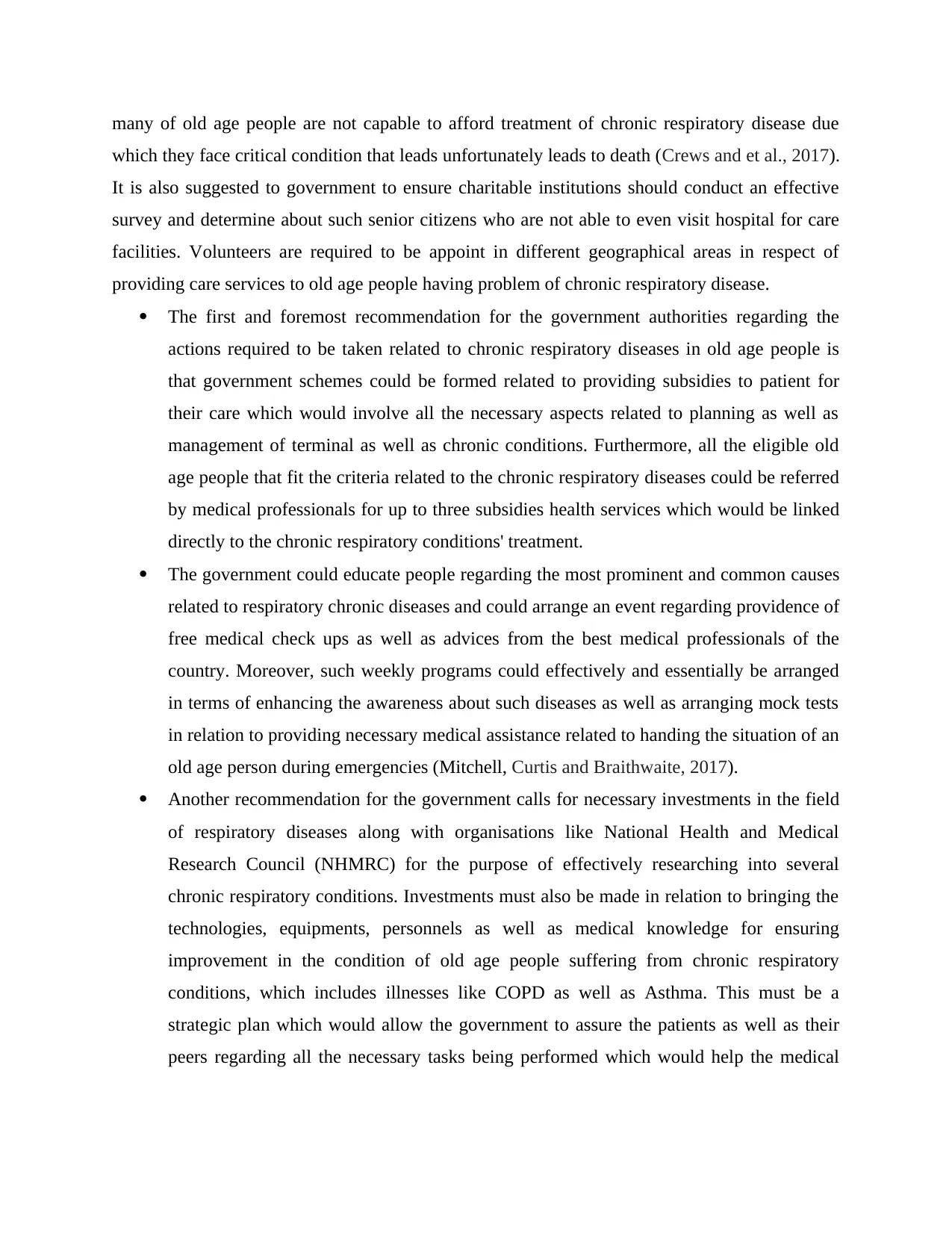
many of old age people are not capable to afford treatment of chronic respiratory disease due
which they face critical condition that leads unfortunately leads to death (Crews and et al., 2017).
It is also suggested to government to ensure charitable institutions should conduct an effective
survey and determine about such senior citizens who are not able to even visit hospital for care
facilities. Volunteers are required to be appoint in different geographical areas in respect of
providing care services to old age people having problem of chronic respiratory disease.
The first and foremost recommendation for the government authorities regarding the
actions required to be taken related to chronic respiratory diseases in old age people is
that government schemes could be formed related to providing subsidies to patient for
their care which would involve all the necessary aspects related to planning as well as
management of terminal as well as chronic conditions. Furthermore, all the eligible old
age people that fit the criteria related to the chronic respiratory diseases could be referred
by medical professionals for up to three subsidies health services which would be linked
directly to the chronic respiratory conditions' treatment.
The government could educate people regarding the most prominent and common causes
related to respiratory chronic diseases and could arrange an event regarding providence of
free medical check ups as well as advices from the best medical professionals of the
country. Moreover, such weekly programs could effectively and essentially be arranged
in terms of enhancing the awareness about such diseases as well as arranging mock tests
in relation to providing necessary medical assistance related to handing the situation of an
old age person during emergencies (Mitchell, Curtis and Braithwaite, 2017).
Another recommendation for the government calls for necessary investments in the field
of respiratory diseases along with organisations like National Health and Medical
Research Council (NHMRC) for the purpose of effectively researching into several
chronic respiratory conditions. Investments must also be made in relation to bringing the
technologies, equipments, personnels as well as medical knowledge for ensuring
improvement in the condition of old age people suffering from chronic respiratory
conditions, which includes illnesses like COPD as well as Asthma. This must be a
strategic plan which would allow the government to assure the patients as well as their
peers regarding all the necessary tasks being performed which would help the medical
which they face critical condition that leads unfortunately leads to death (Crews and et al., 2017).
It is also suggested to government to ensure charitable institutions should conduct an effective
survey and determine about such senior citizens who are not able to even visit hospital for care
facilities. Volunteers are required to be appoint in different geographical areas in respect of
providing care services to old age people having problem of chronic respiratory disease.
The first and foremost recommendation for the government authorities regarding the
actions required to be taken related to chronic respiratory diseases in old age people is
that government schemes could be formed related to providing subsidies to patient for
their care which would involve all the necessary aspects related to planning as well as
management of terminal as well as chronic conditions. Furthermore, all the eligible old
age people that fit the criteria related to the chronic respiratory diseases could be referred
by medical professionals for up to three subsidies health services which would be linked
directly to the chronic respiratory conditions' treatment.
The government could educate people regarding the most prominent and common causes
related to respiratory chronic diseases and could arrange an event regarding providence of
free medical check ups as well as advices from the best medical professionals of the
country. Moreover, such weekly programs could effectively and essentially be arranged
in terms of enhancing the awareness about such diseases as well as arranging mock tests
in relation to providing necessary medical assistance related to handing the situation of an
old age person during emergencies (Mitchell, Curtis and Braithwaite, 2017).
Another recommendation for the government calls for necessary investments in the field
of respiratory diseases along with organisations like National Health and Medical
Research Council (NHMRC) for the purpose of effectively researching into several
chronic respiratory conditions. Investments must also be made in relation to bringing the
technologies, equipments, personnels as well as medical knowledge for ensuring
improvement in the condition of old age people suffering from chronic respiratory
conditions, which includes illnesses like COPD as well as Asthma. This must be a
strategic plan which would allow the government to assure the patients as well as their
peers regarding all the necessary tasks being performed which would help the medical
Paraphrase This Document
Need a fresh take? Get an instant paraphrase of this document with our AI Paraphraser
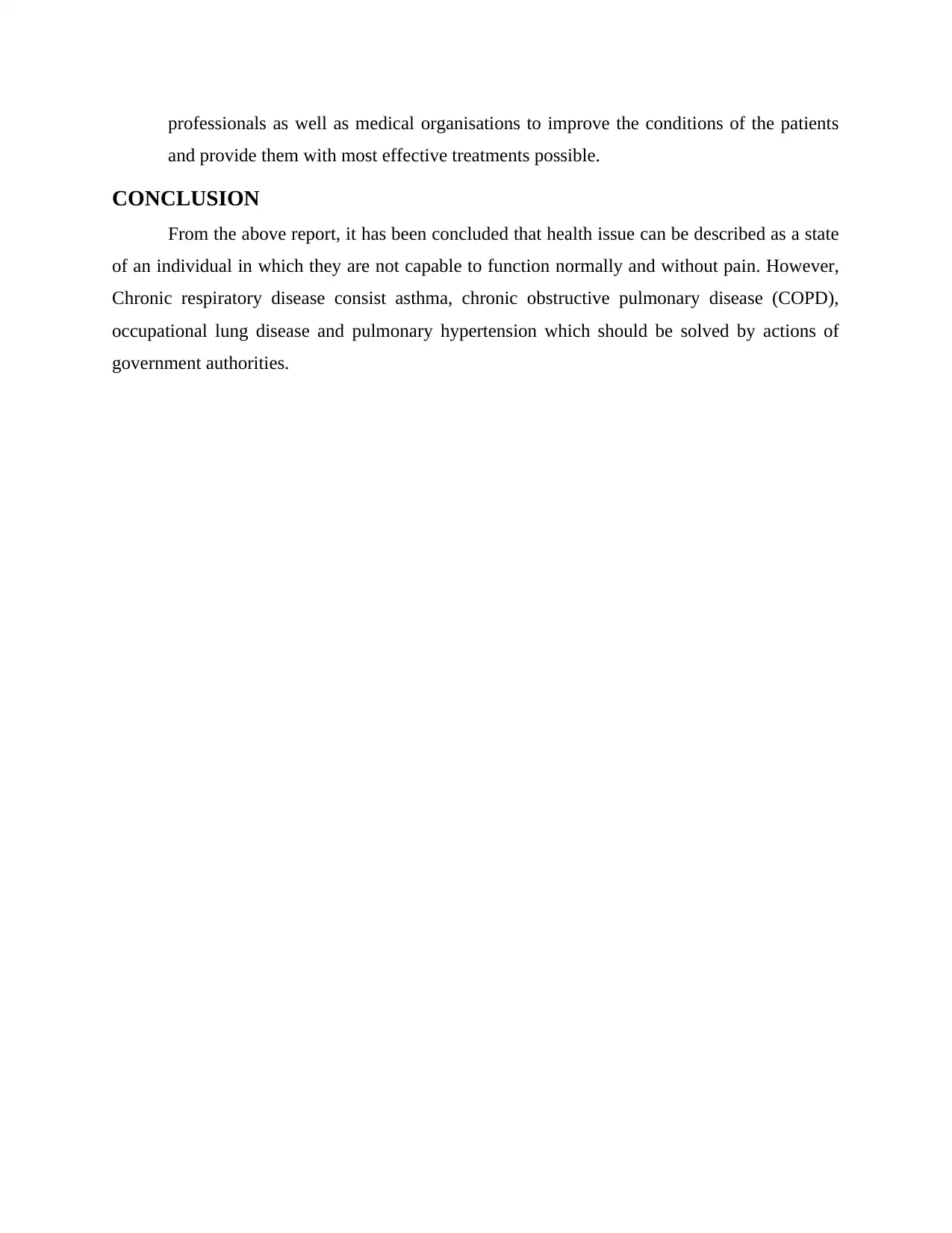
professionals as well as medical organisations to improve the conditions of the patients
and provide them with most effective treatments possible.
CONCLUSION
From the above report, it has been concluded that health issue can be described as a state
of an individual in which they are not capable to function normally and without pain. However,
Chronic respiratory disease consist asthma, chronic obstructive pulmonary disease (COPD),
occupational lung disease and pulmonary hypertension which should be solved by actions of
government authorities.
and provide them with most effective treatments possible.
CONCLUSION
From the above report, it has been concluded that health issue can be described as a state
of an individual in which they are not capable to function normally and without pain. However,
Chronic respiratory disease consist asthma, chronic obstructive pulmonary disease (COPD),
occupational lung disease and pulmonary hypertension which should be solved by actions of
government authorities.
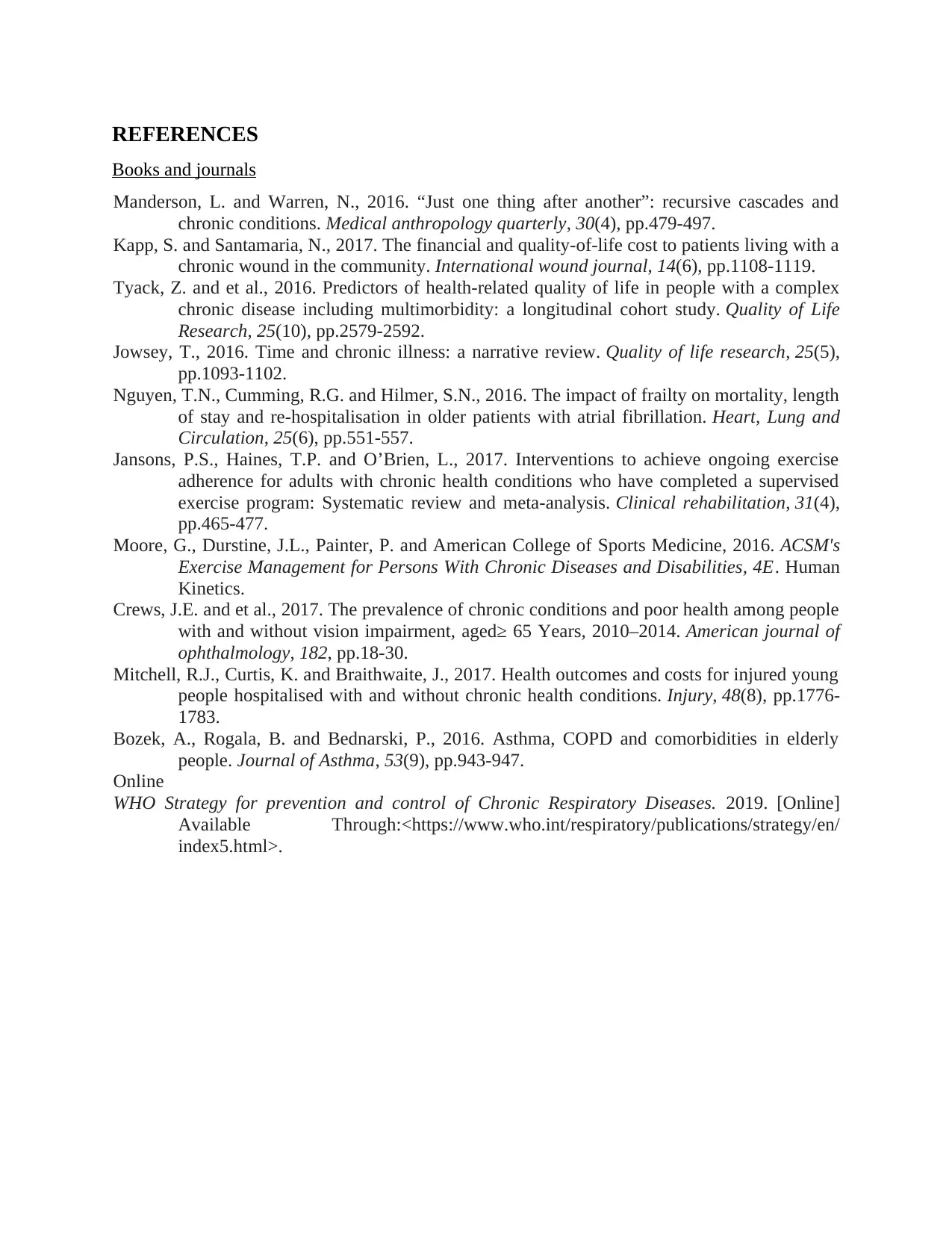
REFERENCES
Books and journals
Manderson, L. and Warren, N., 2016. “Just one thing after another”: recursive cascades and
chronic conditions. Medical anthropology quarterly, 30(4), pp.479-497.
Kapp, S. and Santamaria, N., 2017. The financial and quality‐of‐life cost to patients living with a
chronic wound in the community. International wound journal, 14(6), pp.1108-1119.
Tyack, Z. and et al., 2016. Predictors of health-related quality of life in people with a complex
chronic disease including multimorbidity: a longitudinal cohort study. Quality of Life
Research, 25(10), pp.2579-2592.
Jowsey, T., 2016. Time and chronic illness: a narrative review. Quality of life research, 25(5),
pp.1093-1102.
Nguyen, T.N., Cumming, R.G. and Hilmer, S.N., 2016. The impact of frailty on mortality, length
of stay and re-hospitalisation in older patients with atrial fibrillation. Heart, Lung and
Circulation, 25(6), pp.551-557.
Jansons, P.S., Haines, T.P. and O’Brien, L., 2017. Interventions to achieve ongoing exercise
adherence for adults with chronic health conditions who have completed a supervised
exercise program: Systematic review and meta-analysis. Clinical rehabilitation, 31(4),
pp.465-477.
Moore, G., Durstine, J.L., Painter, P. and American College of Sports Medicine, 2016. ACSM's
Exercise Management for Persons With Chronic Diseases and Disabilities, 4E. Human
Kinetics.
Crews, J.E. and et al., 2017. The prevalence of chronic conditions and poor health among people
with and without vision impairment, aged≥ 65 Years, 2010–2014. American journal of
ophthalmology, 182, pp.18-30.
Mitchell, R.J., Curtis, K. and Braithwaite, J., 2017. Health outcomes and costs for injured young
people hospitalised with and without chronic health conditions. Injury, 48(8), pp.1776-
1783.
Bozek, A., Rogala, B. and Bednarski, P., 2016. Asthma, COPD and comorbidities in elderly
people. Journal of Asthma, 53(9), pp.943-947.
Online
WHO Strategy for prevention and control of Chronic Respiratory Diseases. 2019. [Online]
Available Through:<https://www.who.int/respiratory/publications/strategy/en/
index5.html>.
Books and journals
Manderson, L. and Warren, N., 2016. “Just one thing after another”: recursive cascades and
chronic conditions. Medical anthropology quarterly, 30(4), pp.479-497.
Kapp, S. and Santamaria, N., 2017. The financial and quality‐of‐life cost to patients living with a
chronic wound in the community. International wound journal, 14(6), pp.1108-1119.
Tyack, Z. and et al., 2016. Predictors of health-related quality of life in people with a complex
chronic disease including multimorbidity: a longitudinal cohort study. Quality of Life
Research, 25(10), pp.2579-2592.
Jowsey, T., 2016. Time and chronic illness: a narrative review. Quality of life research, 25(5),
pp.1093-1102.
Nguyen, T.N., Cumming, R.G. and Hilmer, S.N., 2016. The impact of frailty on mortality, length
of stay and re-hospitalisation in older patients with atrial fibrillation. Heart, Lung and
Circulation, 25(6), pp.551-557.
Jansons, P.S., Haines, T.P. and O’Brien, L., 2017. Interventions to achieve ongoing exercise
adherence for adults with chronic health conditions who have completed a supervised
exercise program: Systematic review and meta-analysis. Clinical rehabilitation, 31(4),
pp.465-477.
Moore, G., Durstine, J.L., Painter, P. and American College of Sports Medicine, 2016. ACSM's
Exercise Management for Persons With Chronic Diseases and Disabilities, 4E. Human
Kinetics.
Crews, J.E. and et al., 2017. The prevalence of chronic conditions and poor health among people
with and without vision impairment, aged≥ 65 Years, 2010–2014. American journal of
ophthalmology, 182, pp.18-30.
Mitchell, R.J., Curtis, K. and Braithwaite, J., 2017. Health outcomes and costs for injured young
people hospitalised with and without chronic health conditions. Injury, 48(8), pp.1776-
1783.
Bozek, A., Rogala, B. and Bednarski, P., 2016. Asthma, COPD and comorbidities in elderly
people. Journal of Asthma, 53(9), pp.943-947.
Online
WHO Strategy for prevention and control of Chronic Respiratory Diseases. 2019. [Online]
Available Through:<https://www.who.int/respiratory/publications/strategy/en/
index5.html>.
⊘ This is a preview!⊘
Do you want full access?
Subscribe today to unlock all pages.

Trusted by 1+ million students worldwide
1 out of 12
Related Documents
Your All-in-One AI-Powered Toolkit for Academic Success.
+13062052269
info@desklib.com
Available 24*7 on WhatsApp / Email
![[object Object]](/_next/static/media/star-bottom.7253800d.svg)
Unlock your academic potential
Copyright © 2020–2025 A2Z Services. All Rights Reserved. Developed and managed by ZUCOL.




